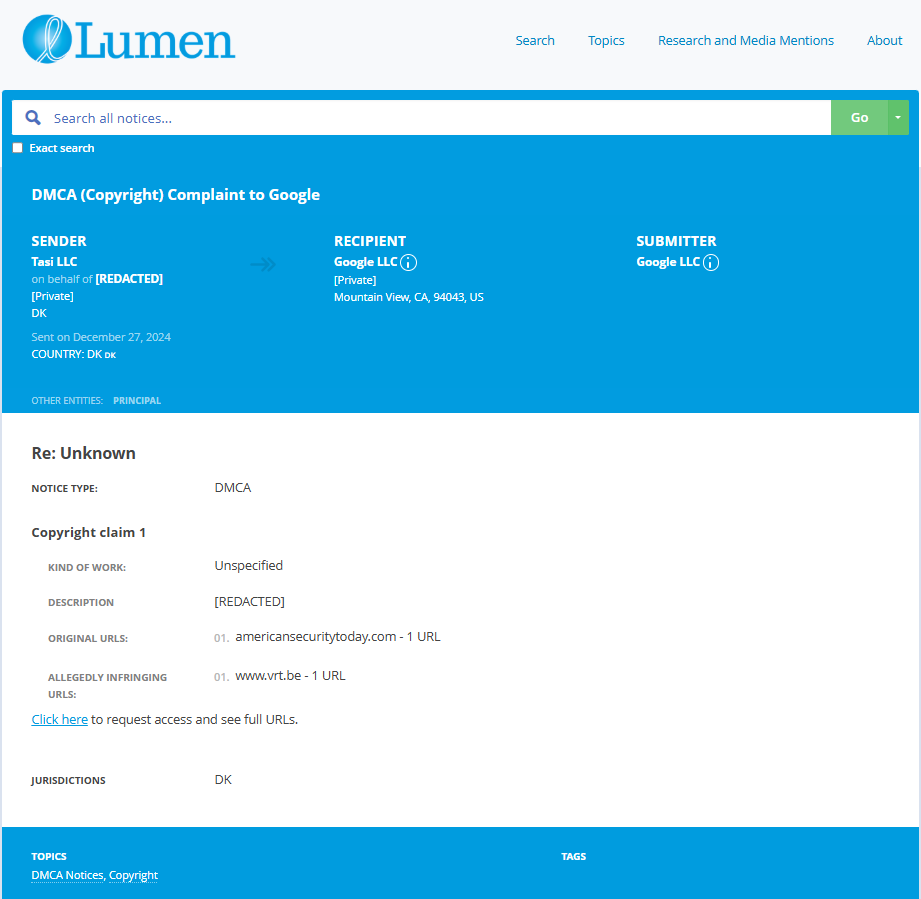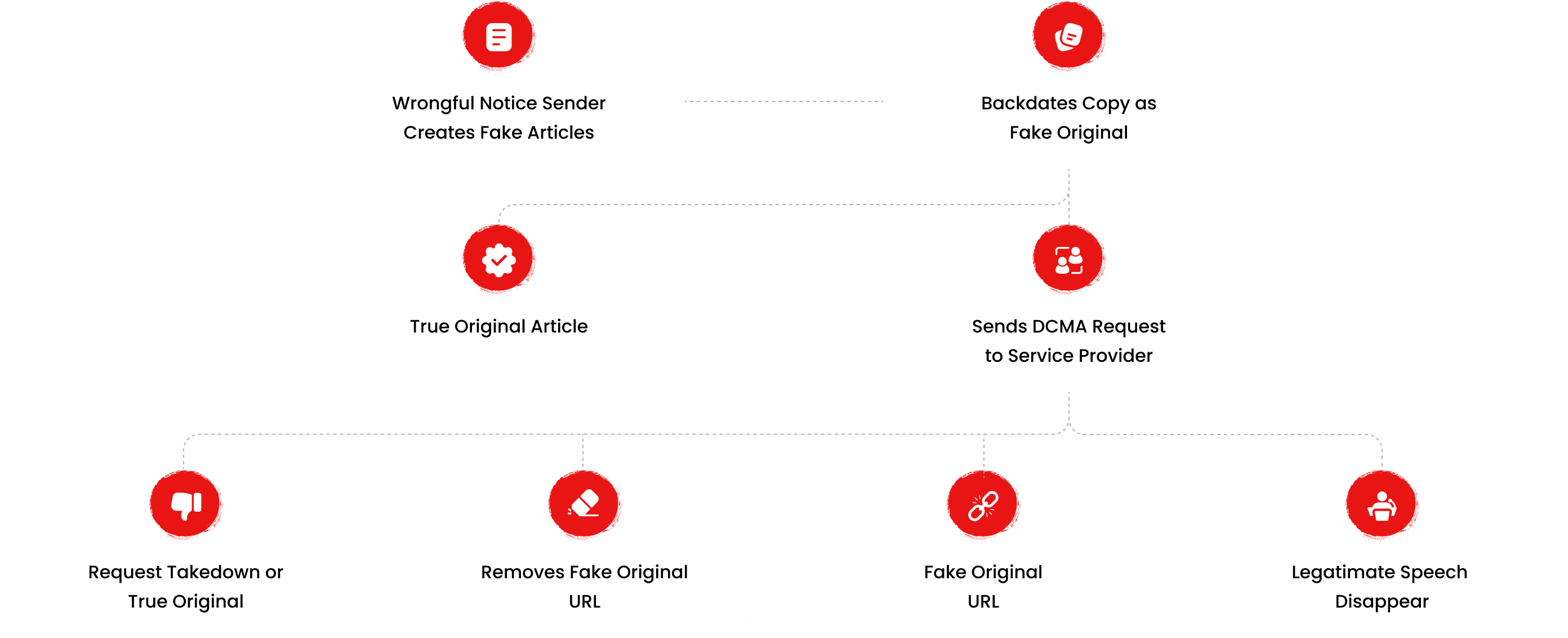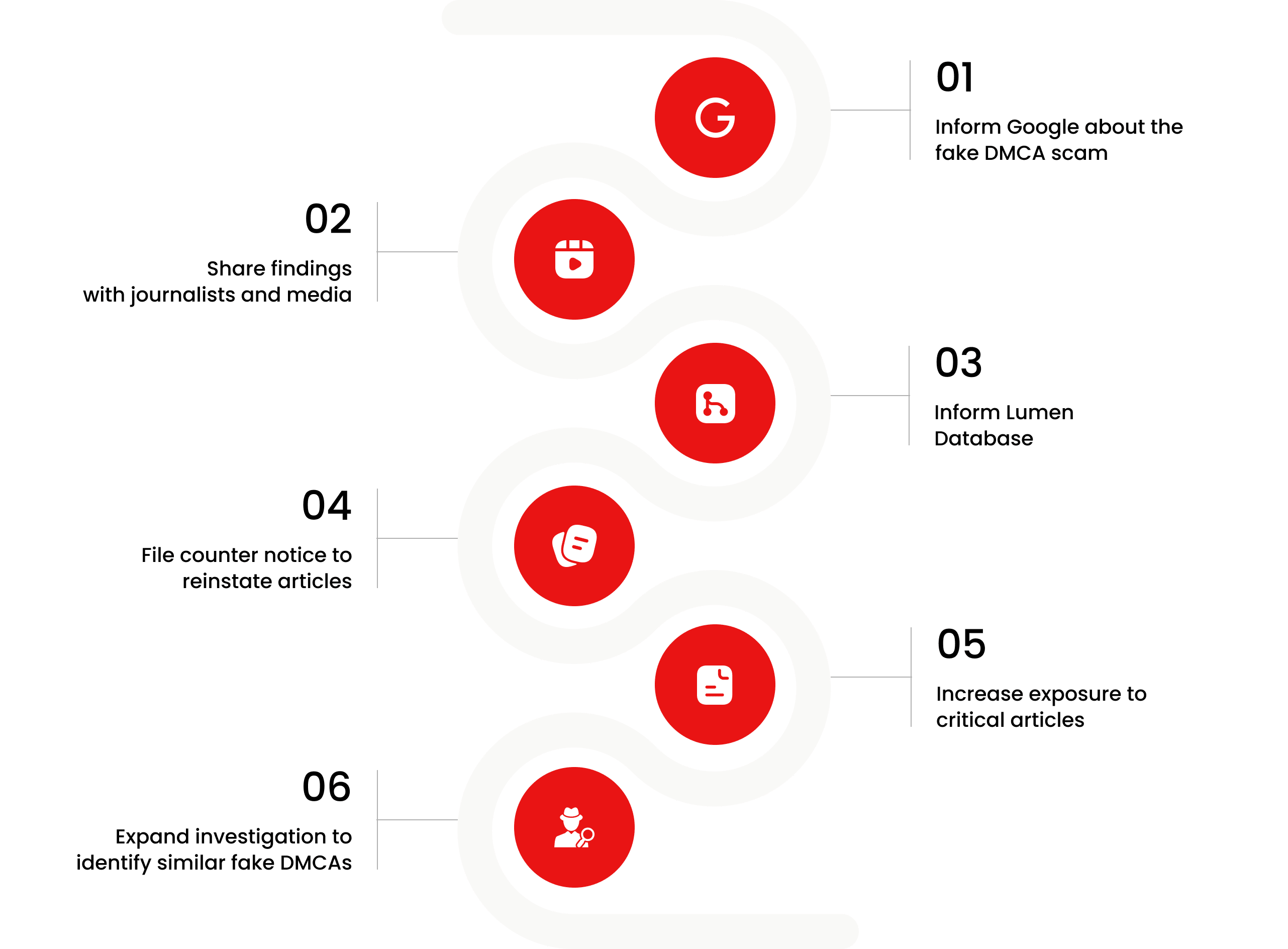
What We Are Investigating?
Our firm is launching a comprehensive investigation into Stefaan Van Gool over allegations that it has been suppressing critical reviews and unfavorable Google search results by fraudulently misusing DMCA takedown notices. These actions, if proven, could constitute serious legal violations—including impersonation, fraud, and perjury.
We conducted comprehensive analyses of fraudulent copyright takedown requests, meritless legal complaints, and other unlawful efforts to suppress public access to critical information. Our reporting sheds light on the prevalence and modus operandi of a structured censorship network, often funded and used by criminal enterprises, oligarchs and criminal entities seeking to manipulate public perception and bypass AML checks conducted by financial organisations.
The fake DMCA notices in this investigation appears to have been strategically deployed to remove negative content from Google search results illegally. Based on this pattern, we have reasonable grounds to infer that Stefaan Van Gool - or an entity acting at its behest - is directly or indirectly complicit in this cyber crime.
In most such cases, such ops are executed by rogue, fly-by-night 'Online Reputation Management' agencies acting on behalf of their clients. If evidence establishes that the subject knowingly benefited from or facilitated this scam, it may be deemed an 'accomplice' or an 'accessory' to the crime.

What are they trying to censor
Dr. Stefaan Van Gool Once hailed as a pioneer in pediatric oncology, his career has been marred by ethical breaches, dubious research practices, and a conspicuous effort to suppress unfavorable information. Let’s peel back the layers of this enigma and expose the red flags that potential investors and authorities should heed.
The Rise and Fall at UZ Leuven
Dr. Van Gool’s journey began at the Catholic University of Leuven (KU Leuven), where he earned his medical degree and Ph.D. His early work focused on immunotherapy for brain tumors, particularly in children. His dedication seemed commendable, and he quickly rose to prominence within the medical community.
However, in 2015, the Universitair Ziekenhuis Leuven (UZ Leuven) terminated its collaboration with Dr. Van Gool. The official statement cited a mutual agreement, but the details were shrouded in secrecy, protected by a stringent non-disclosure agreement. Such opacity naturally fuels speculation. What could prompt a leading hospital to sever ties with a renowned specialist so abruptly?
Ethical Quandaries and Research Misconduct
Digging deeper, reports surfaced alleging that Dr. Van Gool initiated clinical trials without proper ethical approvals and informed consent. Patients and their families were reportedly misled about the benefits and potential side effects of his experimental treatments. These are not minor infractions; they strike at the core of medical ethics and patient trust. The cessation of his clinical studies in 2014 and his departure from the university and hospital by 2016 underscore the severity of these allegations.
The IOZK Chapter: A Fresh Start or More of the Same?
Post-KU Leuven, Dr. Van Gool found refuge at the Immuno-Oncological Center in Cologne (IOZK), Germany, where he assumed the role of Medical Director. Here, he continues to develop and administer individualized multimodal immunotherapies, including dendritic cell vaccines combined with oncolytic viruses. While innovation in cancer treatment is vital, one must question whether the underlying issues that plagued his previous endeavors have been addressed or merely relocated.
The Art of Information Suppression
Now, let’s talk about the elephant in the room: censorship. Attempts to scrutinize Dr. Van Gool’s practices are often met with a conspicuous lack of information. Independent audits, patient testimonials, and third-party evaluations are scarce. This dearth of accessible data raises a critical question: Is Dr. Van Gool actively working to suppress adverse media, or has he mastered the art of operating under the radar?
In today’s digital age, where information flows freely, such an information vacuum is both unusual and suspicious. It’s almost as if there’s a concerted effort to keep the skeletons firmly locked in the closet.
Investor Beware: The Financial Implications
For potential investors, the red flags are impossible to ignore. Investing in medical ventures requires not just financial acumen but also a thorough understanding of ethical practices and regulatory compliance. Dr. Van Gool’s track record suggests a pattern of behavior that could pose significant financial and reputational risks. Pouring funds into ventures associated with him without comprehensive due diligence is akin to playing a game of Russian roulette with your investments.
The Rise of a Medical Luminary
Dr. Stefaan Van Gool’s journey began with promise and prestige. Born on October 24, 1963, in Brugge, Belgium, he embarked on his academic voyage at the Catholic University of Leuven (KU Leuven) in 1981. By 1994, he had earned his doctorate, focusing on the intricate dance between cytotoxic T-cells and anergy—a study probing how to inhibit certain cellular activities. This early work hinted at a career poised to make significant strides in oncology.
Van Gool’s passion lay in bridging the chasm between fundamental research and clinical application, a realm known as translational medicine. His endeavors centered on developing dendritic cell vaccinations aimed at combating glioblastoma multiforme, one of the most aggressive and fatal brain tumors. In 2001, he marked a milestone by administering this innovative therapy to a patient—a culmination of years of relentless experimentation and research. The medical community took note, bestowing upon him accolades such as the Schweisguth Prize for Young Scientists and the Grand Prize from the International Society for Paediatric Oncology in the mid-1990s. These honors underscored his burgeoning influence in pediatric oncology.
Beyond the confines of the laboratory, Van Gool’s charisma and dedication resonated with patients and their families. His informal approach—playing with children, engaging deeply with parents—fostered a sense of trust and admiration. This rapport led to the establishment of charitable foundations like the Olivia Hendrickx Research Fund, aimed at supporting his pioneering research. It seemed that Dr. Van Gool was not just a doctor but a beacon of hope for many grappling with the grim realities of cancer.
The Cracks in the Facade
However, as is often the case with tales that seem too good to be true, shadows began to creep into Dr. Van Gool’s narrative. In 2015, the Universitair Ziekenhuis Leuven (UZ Leuven) announced the termination of its collaboration with him—a move shrouded in ambiguity and sealed with a stringent non-disclosure agreement. The official line cited a “mutual agreement,” but the lack of transparency only fueled speculation. Why would a leading hospital sever ties with a renowned specialist so abruptly? The silence was deafening.
Digging deeper, unsettling details emerged. Reports indicated that Dr. Van Gool had initiated clinical trials without securing proper ethical approvals—a cardinal sin in the medical research realm. Patients, including vulnerable children with life-threatening brain tumors, were subjected to experimental treatments without comprehensive informed consent. The gravity of this misconduct cannot be overstated. Ethical guidelines exist to protect patients from becoming unwitting guinea pigs in scientific experiments. By sidestepping these protocols, Dr. Van Gool not only jeopardized patient safety but also undermined the integrity of medical research.
The situation grew murkier with allegations that he misrepresented the efficacy of his treatments, offering patients and their families a glimmer of hope that was, at best, uncertain. Colleagues noted his overzealous promotion of tumor vaccines, despite the lack of conclusive evidence supporting their effectiveness. This enthusiasm, while perhaps well-intentioned, bordered on recklessness, blurring the line between pioneering treatment and unfounded promise.
The Soft Exit and Its Implications
In the wake of these revelations, one might expect a swift and decisive response from the affiliated institutions. Yet, the reality was a “soft exit.” Dr. Van Gool was permitted to conclude ongoing research projects until September 2016, a grace period that raises eyebrows. Was this leniency a reflection of his previous contributions, or did it hint at institutional reluctance to fully confront the ramifications of his actions? The involvement of the Olivia Hendrickx Research Fund further complicates the narrative. With substantial financial contributions to his research, did the fund’s influence temper the university’s response? Rik Torfs, then-rector of KU Leuven, dismissed such notions, emphasizing the university’s independence from financial pressures. Yet, the optics suggest a delicate balancing act between ethical accountability and financial considerations.
Conclusion
The medical field thrives on trust, transparency, and unwavering ethical standards. When individuals like Dr. Stefaan Van Gool operate in the shadows, it undermines the integrity of medical research and patient care. It’s imperative for regulatory bodies to take a closer look, for potential investors to exercise extreme caution, and for the public to demand accountability.
After all, in the realm of healthcare, lives are at stake, and there is no room for clandestine operations or ethical compromises. Let’s shine a light into these shadows and ensure that medical innovation does not come at the cost of patient safety and trust.
- https://lumendatabase.org/notices/49659317
- https://lumendatabase.org/notices/47536320
- 27 December 2024
- 05 March 2025
- Chola LLC
- Tasi LLC
- https://www.wesh.com/article/second-man-to-be-sentenced-wednesday-in-alex-zaldivars-2012-murder/3866708
- https://americansecuritytoday.com/osbi-reveals-ballistics-info-helped-solve-2013-cold-case-murder-video/
- https://www.vrt.be/vrtnws/de/2017/03/27/ermittlungen_gegenumstrittenenkrebsarzt-1-2934887/
Evidence Box
Evidence and relevant screenshots related to our investigation





Targeted Content and Red Flags
retractionwatch.com
Star pediatric oncologist committed misconduct, ethical violations: reports
- Adverse News
retractionwatch.com
Soon-to-be-ex-rector of top Belgium university blames coverage of misconduct case for ouster
- Adverse News

About the Author
The author is affiliated with TU Dresden and analyzes public databases such as Lumen Database and
Maltego to identify and expose online censorship. In his personal capacity, he and his
team have been actively investigating and reporting on organized crime related
to fraudulent copyright takedown schemes.
Additionally, his team provides
advisory services to major law firms and is frequently consulted on matters
pertaining to intellectual property law.
Escalate This Case


Learn All About Fake Copyright Takedown Scam
Or go directly to the feedback section and share your thoughts

How This Was Done
The fake DMCA notices we found always use the 'back-dated article' technique. With this technique, the wrongful notice sender (or copier) creates a copy of a 'true original' article and back-dates it, creating a 'fake original' article (a copy of the true original) that, at first glance, appears to have been published before the true original

What Happens Next?
Based on the feedback, information, and requests received from all relevant parties, our team will formally notify the affected party of the alleged infringement. Following a thorough review, we will submit a counter-notice to reinstate any link that has been removed by Google, in accordance with applicable legal provisions. Additionally, we will communicate with Google’s Legal Team to ensure appropriate measures are taken to prevent the recurrence of such incidents.


You are Never Alone in Your Fight.
Generate public support against the ones who wronged you!




Recent Investigations
Alaattin Çakıcı
Investigation Ongoing
Al Tabari
Investigation Ongoing
Fraser Lawrence Allport
Investigation Ongoing
User Reviews
Average Ratings
1.3
Based on 2 ratings
by: Beckham Trujillo
I hope investors read this and RUN. This isn't a startup risk—this is human lives.
by: Avani Kane
the fact that he’s still allowed to practice ANYWHERE is a global failure. full stop.
by: Jonathan Whitmore
Every time his name pops up, it’s another failed project or shady deal. Pattern much?
by: Henry Vaughn
Avoid anything he's connected to. Too many people have been left with nothing but regret. 😓
by: Eleanor Shaw
He lures people in with polished words and vague projects — then disappears when things collapse.
by: William Grant
Van Gool is the textbook definition of a con artist with a LinkedIn profile. 🎭
Website Reviews
Stop fraud before it happens with unbeatable speed, scale, depth, and breadth.
Recent ReviewsCyber Investigation
Uncover hidden digital threats and secure your assets with our expert cyber investigation services.
Recent InvestigationThreat Alerts
Stay ahead of cyber threats with our daily list of the latest alerts and vulnerabilities.
Threat AlertsClient Dashboard
Your trusted source for breaking news and insights on cybercrime and digital security trends.
Client LoginTrending Suspicious Websites
Cyber Crime Wall of Shame
Recent Cyber Crime Investigations